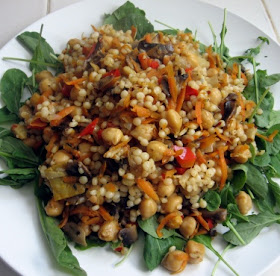14 May 2012
Israeli couscous with chickpeas & Mediterranean vegetables
This is just about exactly what I want to eat for lunch every day: a giant mess of vegetables, pasta or grains (I tend to treat Israeli couscous as a grain and not as pasta at all), and chickpeas or another appropriate pulse.
At the same time, this is a totally standard and normal thing for me to eat. Does that mean it's boring? No. No, it does not. In fact, it's super easy to vary this dish based on the different vegetables, grains, and pulses you may have. No chickpeas? Throw in some navy beans, green or black lentils, giant cannellini, or black-eyed peas. No Israeli couscous? Steam rice, barley, millet, or quinoa, make a big pot of polenta, boil some gemelli, fettuccine, or conchiglie, or go a totally different direction and whip up some baked or mashed potatoes, sweet or otherwise. And of course the vegetables can be pretty much anything you want, as long as you get some allium content in there.
I tend to gravitate toward a mix of Mediterranean vegetables: artichoke hearts, peppers, lemon, oregano, olives. These highly flavored vegetables make for an especially nice combination with the more neutral chickpeas.
Israeli couscous with chickpeas & Mediterranean vegetables
For couscous:
olive oil
onion
Israeli couscous
water or veg broth
For veg:
olive oil again
onion &/or garlic
mushrooms
artichoke hearts
carrot
red bell pepper
cooked, drained chickpeas
dry vermouth to deglaze
salt, pepper
oregano, marjoram, red pepper flake
maybe some lemon juice or white wine vinegar to finish
arugula or other nice salad greens of your choice
optional parsley & grating cheese for garnish
Game plan: put couscous on to cook; make veg; combine; plate over all the delicious greens you desire.
I cook Israeli couscous like a grain, in what is essentially a simple pilaf preparation. So. Start by warming a slug of olive oil in the bottom of a 3-quart pot with a lid. Dice up a medium onion and add it to the oil. Let cook to soften for about 3-5 minutes. (While you're waiting, you can start chopping up veg.) When the onion has turned soft, add in a cup of couscous.
Now it's time to add your liquid. The formula here is a little odd. Instead of adding 1.5X the volume of couscous (which I think is close to correct), you want to add water just to cover the couscous, then add the same amount of water as couscous. Since we're making one cup of couscous, we'll add one more cup of water.
You can vary this formula for any amount of couscous. For 2 cups of couscous, you'd just cover the couscous with water and then add 2 more cups; if you were making 2/3 cup, you'd cover the couscous with water and add another 2/3 cup of water. Makes sense?
Cover the pan, bring it up to a fast simmer, turn the heat to low, and cook for about 10-15 minutes, or until all the water is absorbed. Voila! Israeli couscous!
Okay. While the couscous is cooking, get out a wide saute pan and cook your vegetables. Start by dicing and sauteing half an onion and a couple cloves of garlic in a little olive oil. Gradually chop and add the vegetables, starting with the mushrooms and proceeding down the list in order of how long they take to cook. Shred the carrot instead of chopping it if you so desire; I did. Season with salt, pepper, oregano, marjoram, and maybe some red pepper flake if you want some spice. Add the chickpeas and continue to cook for a good five minutes, or until things are cooked through to your liking. Deglaze with some dry vermouth and let cook another couple minutes before you turn off the heat.
Check to make sure your couscous is finished, stir it up, and add it to your vegetable pan. Taste and correct the seasonings. If you want a little acid, you can add a squeeze of lemon juice or a splash of white wine vinegar. Lemon zest might be good here too.
To serve, cover a plate with salad greens of your choice. I personally prefer darker greens, so I used arugula, but just about any salad green that can stand a light wilting would probably work out fine.
Do you want garnish? Chopped parsley is definitely great here; basil would probably be good as well. A dusting of grating cheese--parmesan, romano, pecorino, whatever--is also a good move.
I like to stir everything up into a big mess before eating it. You know the messiest food tastes the best, right? Hooray for mess!



Yum! That looks so good and very spring-like. I was just thinking I don't eat couscous nearly enough. Love the flavors of Mediterranean vegetables! :-)
ReplyDeleteI love the mix of flavours and mediterranean vegetables in this dish and the fact you can use it with other grains. Lovely colours too :)
ReplyDeleteLove the bed of arugula! I haven't been able to make Israeli cous cous for ages, craving it now, nom!
ReplyDeleteI agree that usually the messiest is the most flavorful! That looks awesome, and I love all those Mediterranean flavors.
ReplyDeleteI almost forgot couscous existed--I can't remember the last time I had it. Thanks for the heads up! This is the perfect Mediterranean dish!
ReplyDeleteSo glad you guys like it! I loooove Israeli couscous...I wish I'd made triple amounts of this so I could be eating more now. :)
ReplyDeleteI have still never tried Israeli couscous, I will definitely have to try it in a salad this summer. Looks yummy!
ReplyDelete